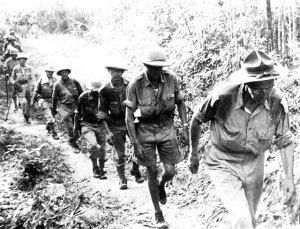![]() The Pacific War Online Encyclopedia
The Pacific War Online Encyclopedia
|
| Previous: Reserves | Table of Contents | Next: Revenge Class, British Battleships |

National Archives.
Via ibiblio.org
A retreat is the movement of a military force away from an enemy force or back on its own lines of supply. The military prefers the term "retrograde movement" and makes a distinction between a withdrawal, in which the retreating force breaks contact with the enemy to make an orderly retreat; a retirement, in which the retreating force is already out of contact with the enemy when it begins its retreat; and a delaying action or fighting withdrawal, in which the retreating force remains in contact with the enemy, seeking to inflict as much damage and delay on the enemy as possible.
MacArthur's retreat from Lingayen Gulf was a good example of a fighting withdrawal. The retreating North Luzon Force sought to delay the Japanese long enough for South Luzon Force to move into Bataan and for defensive positions to be prepared.
The Allied troops carried out their withdrawal with more skill than
might have been expected of such green troops, holding a line during the
day to force the Japanese to deploy out of column for a set piece battle, then retreating under cover of night to avoid being engaged and overwhelmed.
A rout is a disorderly retreat involving at least some degree of breakdown of discipline. Because almost any retrograde motion is detrimental to morale, there is always some potential for rout in any retreat. However, the likelihood of rout is small for well-trained forces making a retirement and great for poorly-trained troops attempting a withdrawal. Avoiding rout is the most important task of a commander who orders a withdrawal or delaying action, since, once troops are routed, it can be very difficult to restore discipline (rally the troops). Often it is necessary to establish a new line using fresh reserves behind which the retreating force can rally. If there are no reserves or the sight of the routed force destroys the morale of the reserves, then catastrophe looms.
Another challenge in a retreat is that the retreating force loses some of the advantages of defense. It is forced to break cover and it loses some of its advantage of greater familiarity with the battlefield. Some of this disadvantage can be made up by engineers if they have time to destroy bridges, block roads, or lay minefields or other obstacles. This in turn gives the retreating force time to break contact or to find and prepare favorable positions for renewed resistance, as the situation dictates.
No army looked favorably on troops who retreated without permission, but the Japanese were particularly harsh on those who abandoned their position without orders (Tamayama and Nunneley 2000):
A platoon leader came retreating from the front. The battalion commander boiled with anger and slapped his face, and the platoon leader went back, trying to regain his position. Soon he died bravely....
The platoon leader was lucky to be permitted to redeem his honor by
trying to recapture his position. Summary execution was not unknown in
such cases.
Collie and Marutani (2009) interviewed Japanese veterans of the Kokoda campaign who claimed that South Seas Detachment literally didn't know how to retreat. Retreat was considered so shameful that there had been no training in how to make a fighting withdrawal. This may have contributed to the retreat disintegrating into a rout:
At first stupefied by the abandonment of all they had striven for, the soldiers had finally understood that the unimaginable was happening: Japanese soldiers were turning their backs on the enemy, running away. And with that insight came a changed mentality that Okada detected and would later describe: "They were seized with an instinctive desire to live. Neither history nor education had any meaning to them now. Discipline was completely forgotten. Each tried for his life to flee faster than his comrades, and the confusion was worse than it had been at the supply dump. During short respites on the way, we often repeated the popular Japanese saying, "Where there is life, there is hope."
A Japanese captain who fought at Kohima echoed this belief (Tamayama and Nunneley 2000):
On the battlefield if a man feels "I should do this" or "I should defend here", he thinks of nothing other than his mission. If he is told to retreat, he feels that he is saved and wants to stay alive and loses his courage.
However, a Japanese diarist on Guadalcanal put a more positive spin on his unit's retreat following the Battle of Bloody Ridge (Smith 2000):
We had never experienced a retreat like this in the China Incident and it is a very distressing event. When I read this diary in the future I believe I'll be carried away with deep emotions. The faithful heroes in battle are not always found in a victorious attack, but also in defeat. The sight of these men who are enduring hardships and hunger and the afflictions of transporting the wounded is even more beautiful than the picture of them in victory. These are the qualities of only the faithful and well-trained armies. I cannot help but cry when I see the sight of these men marching with no food for four or five days and carrying the wounded through the curving and sloping mountain trail. Hiding my tears I encouraged the weak-willed to march on.
References
Dictionary of Military and Associated Terms (accessed 2010-9-8)
The Pacific War Online Encyclopedia © 2010-2011, 2013 by Kent G. Budge. Index